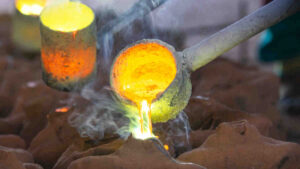Barry FitzGerald: Bitcoin or gold? The battle for your green dollar is just beginning

Pic: metamorworks / iStock / Getty Images Plus via Getty Images
One of the factors behind the recent strength in the price of “old’’ gold – it’s up 5.2% in the last 30 days – has been the attack by Elon Musk on the environmental credentials of cryptocurrencies (namely, Bitcoin), the “new” gold.
The idea is that funds that might otherwise have flowed into cryptocurrencies have been diverted to gold, thanks to Musk’s tweet that Bitcoin would not be accepted for the purchase of a “green” Tesla.
Musk cited the increasing use by crypto “miners” of fossil fuels, particularly emissions intensive coal, sending Bitcoin and others into a tailspin, for a while anyway.
He was not actually exposing a dirty secret about cryptocurrencies as gold producers and others have long noted crypto “miners’’ consume as much power as Sweden does annually.
But hey, the global gold industry is energy intensive as well.
As much as Musk was shining a light on the emissions involved in producing a Bitcoin, he was also highlighting the growing importance investors place on the emissions involved in the production of all things.
In a world increasingly concerned about global warming, the emissions intensity of mining a Bitcoin or an ounce of gold – or any other commodity – has become an important consideration for investors.
And while Musk’s attack on cryptocurrencies might have cheered the gold companies, they know that their own emissions are set to become the subject of greater scrutiny, with the lowest greenhouse gas emitters to benefit.
Super high-grade = low intensity
Increasingly, the best ounce of “old’’ gold is going to be the greenest ounce of gold.
Not to the point where an ounce of green gold fetches a price premium, but certainly to the point where investors will pay a share price premium for a producer of green gold.
All that came into sharp focus in investor presentations by Bellevue (ASX:BGL) managing director Steve Parsons down the east coast this week.
Bellevue is not yet a gold producer. But it is headed to become one in the December quarter next year at an annual rate of 160,000 ounces, enough to place it amongst Australia’s top 25 gold mines.
And because it will be a high-grade producer, Bellevue will also have one of the lowest greenhouse gas emission intensities, if the not the lowest.
Bellevue forecasts its intensity at 0.296 tonnes of carbon dioxide per ounce of gold. Its super high-grade is the single biggest factor in the low intensity.
But the company has also designed the project to be low intensity, including a commitment to use gas-fired power rather diesel power despite the greener option coming at a higher capital cost.
It is also considering taking a further emissions reduction step by using renewable energy.
There is a neat bit of research work by Bellevue’s investor relations team in this week’s presentation handout which shows the emissions intensity of Australia’s top 25 gold mines.
The highest grade operations like Bellevue’s namesake project perform best, while the lowest grade operations perform worst. It is a handy ready reckoner for those that want to include emissions intensity in their screening of companies/projects in which to invest.
Among the highest emitters per ounce of gold produced you will find Australia’s biggest gold mines like Cadia (Newcrest), Telfer (Newcrest), Boddington (Newmont) and the Kalgoorlie Super Pit (Northern Star). All have an emissions intensity of more than 1 tonne of carbon dioxide per ounce.
It is worth noting that such is the pressure for industry to lower its carbon intensity, the big mines are taking what measures they can to improve their ratings.
Newcrest at the Cadia mine near Orange in NSW is an example. The company has sourced power from a wind farm which will become operational in 2024.
It will supply 40% of the project’s power and is part of a commitment by Newcrest to have net zero emissions by 2050.
Related Topics

UNLOCK INSIGHTS
Discover the untold stories of emerging ASX stocks.
Daily news and expert analysis, it's free to subscribe.
By proceeding, you confirm you understand that we handle personal information in accordance with our Privacy Policy.








